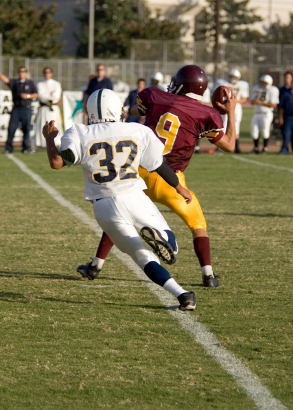- There are 60 concussions in high school football per 100,000 player games or practices (athletic exposures).1
- The concussion rate in high school football has increased at an 8% annually over an 11-year period from 1997 to 2008,1
- Football still accounts for more than half (56.8%) of all concussions in high school sports.2
- According to research by The New York Times,at least 50 youth football players (high school or younger) from 20 different states have died or sustained serious head injuries on the
field since 1997.

- Anecdotal evidence from athletic trainers suggests that only about 5% of high school players suffer a concussion each season, but formal studies surveying players suggest the number is much higher, with close to 50% saying they have experienced concussion signs and symptoms and fully one-third reporting two or more concussions in a single season.
- >According to the National Center for Catastrophic Sport Injury Research, there were 10 spinal cord injuries in football in 2006; since 1977, at least 269 youth, high school, college and pro players have suffered such injuries.
- According to a study reported in the July 2007 issue of The American Journal of Sports Medicine3:
- Football players suffer the most brain injuries of any sport. High school football players have a far higher rate of brain injuries (concussions to massive brain trauma) than collegiate and professional players, a difference the authors characterized as "quite dramatic."
- The rate of catastrophic football head injuries for high school players is three times that of college players, primarily from second impact syndrome.
- An unacceptably high percentage (39%) of high school and collegiate football players suffering catastrophic head injuries (death, nonfatal injury but causing permanent neurologic functional disability and serious injury leaving no permanent functional disability) during the period 1989 to 2002 were still playing with neurologic symptoms at the time of the catastrophic event.
- Computerized
neurocognitive testing, which is being utilized more often in managing concussed athletes at the high school level2 (being used, in one recent study of a large public school system, to assess one out of four (25.7%)
concussions, is less likely to be used in evaluating concussions in injured football players
than athletes injured in other sports, which experts suggest, may be because:
- Schools with limited financial resources are more likely to have football programs, given its popularity, than they are to have other sports;
- School may not be able to afford to purchase computerized test programs (although some, like the Computerized Cognitive Assessment Tool (CCAT) offer cost-effective testing solutions) ; and,
- Football programs may be reluctant to use such testing in the assessment of a concussion for fear that athletes may miss more playing time.
1. Lincoln A, Caswell S, Almquist J, Dunn R, Norris J, Hinton R. "Trends in Concussion Incidence in High School Sports: A Prospective 11-Year Study" Am. J. Sports Med. 30(10) (2011), accessed January 31, 2011 @ http://ajs.sagepub.com/content/early/2011/01/29/0363546510392326.full.pdf+html
2. Meehan W, d'Hemecourt P, Comstock D, High School Concussions in the 2008-2009 Academic Year: Mechanism, Symptoms, and Management. Am. J. Sports. Med. 2010; 38(12): 2405-2409 (accessed December 2, 2010 at http://ajs.sagepub.com/content/38/12/2405.abstract?etoc).
3. Gessel LM. Fields SK. Collins CL. Dick RW. Comstock RD. "Concussions among United States high school and collegiate athletes" J. Athl Train. 2007; 42(4): 495-503.
Revised and updated February 4, 2013








